The betta fish has long been perceived as a solitary creature, notorious for its aggressive tendencies towards tank mates. However, recent insights have shattered this misconception, revealing a realm of compatibility waiting to be explored. With careful consideration of tank size, decor, and the unique temperament of each betta, a harmonious community can be established.
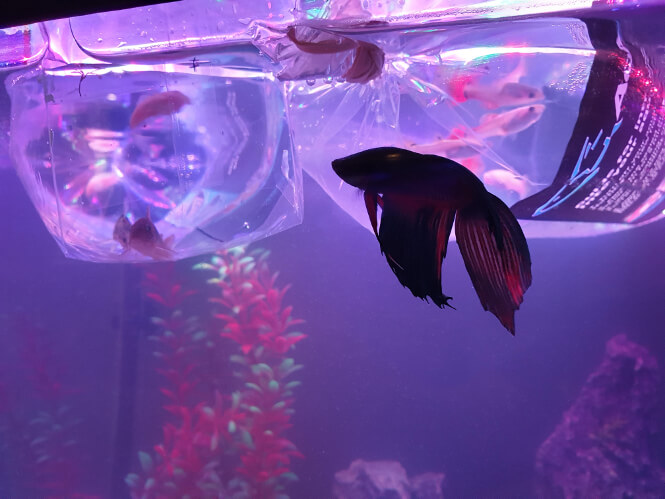
Betta fishes made a name for themselves as the aggressive little fin-nippers that would not really tolerate anything else moving in their tank. However, this reputation has already been disproven too many times because, as you’ll see for yourself, there are fish tank mates compatible with bettas.
Picking good companions for them to live together with is doable as long as you take into account the surrounding decor and the size of your tank.
For example, a betta fish will get along with certain tank mates in a 10-gallon tank but different ones will work in a 5-gallon tank.
What are these fish and how well will they do alongside bettas?
Know that having some live plants in there is essential for a stress-free setup.
The truth is male bettas will be aggressive, but only towards other bettas or fish with similar aggression levels.
Because they were actually bred as fighter fish for a long time in the past they have inherited hostility, but only towards their own kind, or very similar-looking fish.
They also come across as very territorial in the wild, so it’s difficult to establish if it’s a nature versus nurture situation.
A male betta will be hostile to other male and female bettas and should not be kept alongside others of its kind in the same aquarium space.
Transparent dividers do not allow for physical damage but don’t really reduce the stress that comes with glaring between the males.
Females, on the other hand, can live together in a so-called “sorority tank” because they do not seem to show animosity towards one another.
What are some fish tank mates that will get on with your Betta Fish?
The best betta fish tank mates are non-aggressive fish that can swim fast and remain rather small.
Listed below are species that have worked more than once for myself or someone else.
To be compatible and get along with a betta other aquatic inhabitants need to dwell on different levels in the aquarium or to be agile swimmers.
Here’s what type of tank mates will work in a Betta fish tank:
The best tank mates for a Betta fish are peaceful bottom-dwellers such as the Pygmy Corydoras and smaller tropical plecos or dwarf schooling fish that are fast enough to discourage chasings. Good examples of the latter are the Rummy-nose Tetra, Ember tetra, Harlequin Rasbora, the Least Rasbora, and the Pristella Tetra.
In 3, 5, and 10-gallon fish tanks, having an abundance of live plants and hiding places significantly increases the chance of peaceful coexistence between the aquarium companions.
Note that the Betta is a territorial animal and it views newcomers to its home as intruders.
What fish CAN’T go with Bettas and should be avoided as tank mates?

Because of the Betta’s aggressive nature you should avoid putting them alongside fish with large fins.
Fish with large fins that may suffer damage from a Betta’s attack are goldfish, gouramis and other male Bettas. Goldfish also have very different water requirements than that of Bettas.
Also, Betta fish have their own long fins and don’t do well around other fish that like to nip at their tank mates.
Known fin-nippers are the aggressive red-tail and rainbow sharks, tiger barbs, some species of tetras such as the Skirt tetras, and most cichlids.
Finally, in tanks smaller than 20 gallons you’d want to avoid housing Glofish with Bettas.
Here’s a list of fish to avoid keeping as a Betta’s tank mates:
- Goldfish
- Angelfish
- Gouramis
- Other male Betta fish, unless in a large enough tank
- Tiger barbs
- Any type of freshwater puffer fish
- Red-tailed sharks
- Rainbow sharks
- Most cichlids
- Larger loaches
- Serpae tetras
- Skirt tetras
- Emperor tetras
Examples of tank mates for the more aggressive Betta Fish
Research also suggests that the longer it has been living in isolation the higher the chance of aggression.
This demands that a Betta should be introduced last to the community aquarium, especially in smaller fish tanks where space is limited. Otherwise fin-nipping and aggressive behavior may occur.
It’s essential to keep schooling fish in groups of 5 or more or the bullying may turn the other way around.
That being said, here’s a detailed list of creatures that may live and get along with a Betta fish in an aquarium:
- Dwarf danios;
- Dwarf rasboras;
- Small-sized Corydoras;
- A single small pleco;
- Short-finned tetras;
- Agile shrimp (in planted tanks);
- Loaches that don’t grow big;
- Freshwater snail that don’t have long antennae, so preferably no Mystery snails;
- Mini livebearer fish.
Suggested Read: What Are Some Small Pleco Species?
Keep in mind that some bettas will just be too aggressive in their nature and won’t really allow for any tank mates.
In some cases, shrimp may make good tank mates for a Betta fish, but that depends on more than one factor. Visit the link to learn more about this type of setup.
Anyway, in the picture below you’ll see a betta peacefully coexisting with a small school of neon tetras in a 16-gallon fish tank:
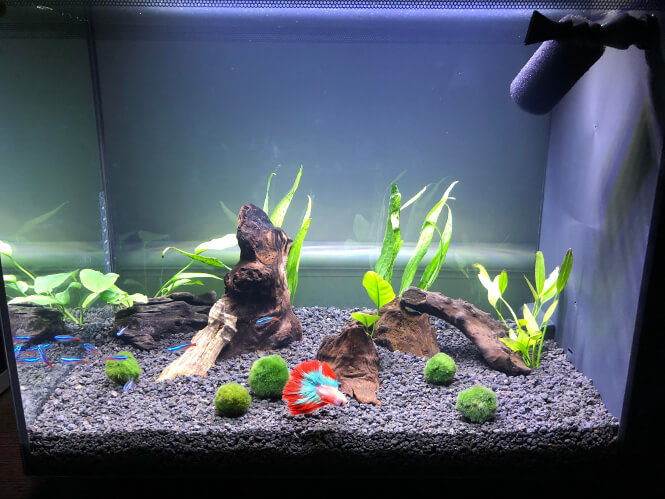
The beautifully designed aquarium in the photo is the Fluval Spec Aquarium Kit, in case you were curious.
Top suggestions for a 3-GALLON tank
In a 3 to 3.5 gallon tank, the options for compatible companions are quite limited.
In such a small space, it’s absolutely crucial that you decorate the tank with heavy foliage.
Bettas are curious and like to scout around plants.
If these are missing the fish may become bored which in turn leads to picking on whoever else is moving in its surroundings.
In a 3-gallon tank consider these as tank mates for your betta:
- Ghost shrimp x2;
- Red Cherry shrimp x2;
- A single horned Nerite snail, to serve as an algae cleaner.
Obviously, as the stocking capacity of a 3-gallon tank is limited choose either of these and not all of them together.
A picture of a betta fish peacefully hanging out with 2 Amano shrimp:
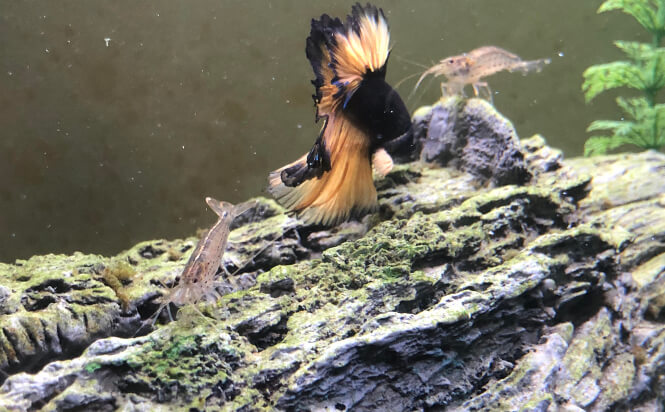
Top suggestions for a 5-GALLON tank
A 5 to 6-gallon fish tank gives you more choices in terms of tank mates for a Betta, but mainly dwarf rasbora species, snails, and shrimp.
Generally speaking, there are many fish and invertebrates that feel comfortable in small tanks.
However, for one with a Betta in it, you should only employ some very small schooling fish and non-aggressive crustaceans or micro snails.
Mystery snails, for example, are large enough to draw the attention of an aggressive Betta.
This type of snail has long antennae which the Betta may mistake for worms.
Mystery snails also forage for food during the day, further increasing the risk of getting in the way of a Betta with anger issues.
If you want to put a snail in your Betta tank you’d want something like the Nerite snail.
Although also active during the day, these snails don’t have obtrusive antennae.
The tank mates mentioned below rarely grow over an inch.
However, to avoid potential conflicts it’s essential that the tank is heavily planted.
Your Betta fish will probably get busy exploring the plants or chill in a hiding spot.
This way there will be no clear line of sight between the inhabitants and the chance for hostile encounters is down to a minimum.
Use driftwood, artificial caves, or non-sharp rock work for hiding places.
For a 5-gallon tank consider these tank mates for a Betta fish:
- Least Rasbora fish x6;
- Danionella Dracula x6;
- Chili Rasboras x6;
- Nerite snail as part of the clean-up crew;
- Male Endlers x3;
- Ghost shrimp x4;
- Amano shrimp x2;
- Red Cherry shrimp x4;
- Neon Blue Rasbora fish x5.
It’s important to note that most of these recommendations are schooling fish and should not be kept in groups of less than 6.
Recommended read: How to Take Care of a Chili Rasbora
See a greedy betta eagerly eating the food of its multiple snail tank mates:
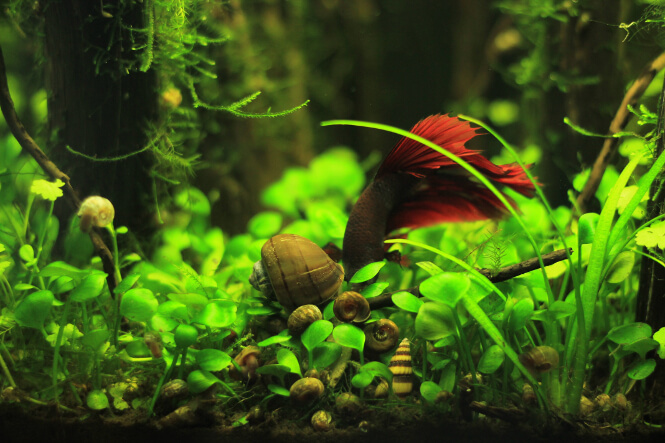
Top for a 10-GALLON tank
With a 10-gallon aquarium for your Betta, there are a plethora of tank mates to choose from, really.
Mind that the rule about having many plants and hiding places still applies here. The biggest mistake I see new fish keepers make is stuffing a betta in a community aquarium with poor decorations.
These fish need personal space and a place to retreat when they feel like resting. The key to having a conflict-free environment is to provide everyone with such places.
I’ve picked fast dwarf swimmers and docile fish that look nothing like a rival in this list.
In a 10-gallon tank you can try these as tank mates for your Betta fish:
- Harlequin Rasboras fish x8;
- Rosy loaches x6;
- Rummy-nose Tetra fish;
- Dwarf African Frogs, 2 to 3 specimens;
- Panda Corydoras x3;
- Ember Tetra fish x6;
- Pristella Tetras x6;
- Platies x3;
- Endlers x6;
- Neon Tetra fish;
- A single Mexican Dwarf Crayfish (with caution);
- Pygmy cories x4;
- Pepper corydoras x4;
- Feeder guppies x6;
- A single Apple snail;
- Cherry shrimp x8;
- Amano shrimp x5;
- Ghost shrimp x8;
- Bamboo shrimp x1.
Same as before most of these fish will need to be in groups because of their social hierarchy.
Pepper Corydoras make one of the best tank mates for a betta fish as seen in the following photograph:
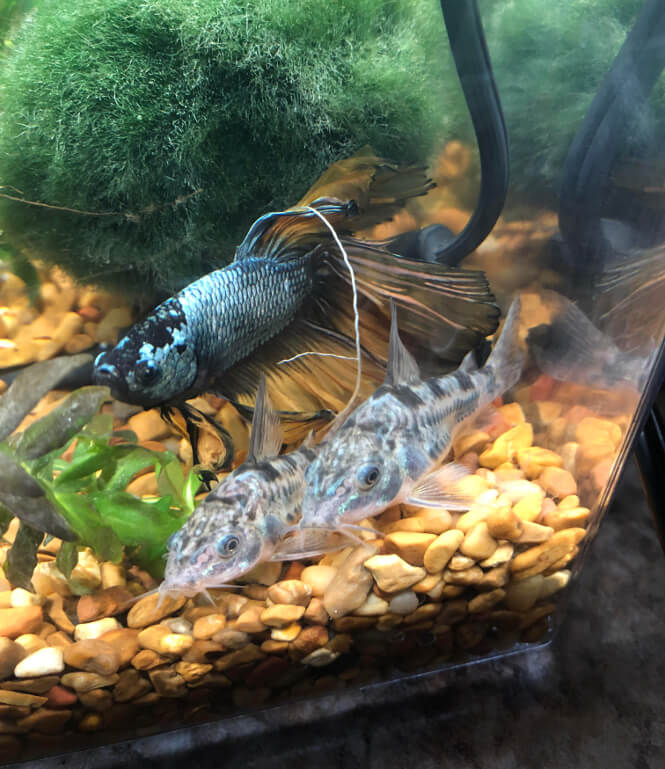
“I’m keeping a close eye on you two.”
Here’s how a betta tank with a couple of pygmy Corydoras (bottom left) looks like in a 10-gallon fish tank:

And another snapshot of a betta living with a school of neon tetra companions in their shared 10-gallon tank:
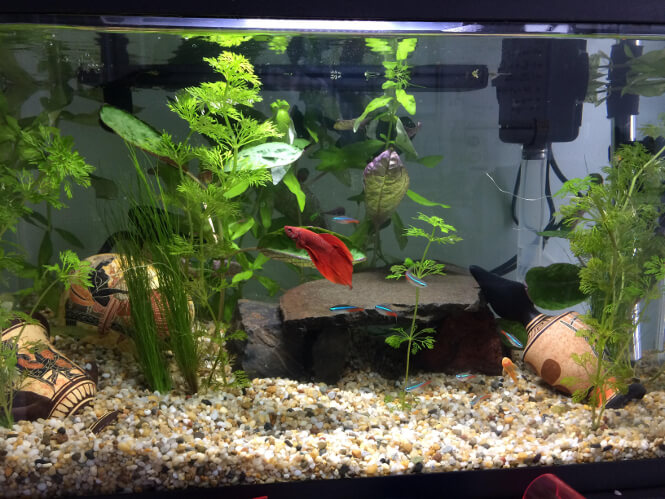
Top suggestions for a 20-GALLON tank
Keeping a Betta in a 20-gallon community tank is the best possible setup for the new fishkeeper.
The space in such a large tank is enough to allow for other fish to compliment the Betta’s appearance without creating too much distraction.
The options for companions increase significantly and become diverse.
Mind that it’s still strongly recommended to furnish the community tank with hiding places such as driftwood, caves, or dense aquatic vegetation.
Have a look at the tank mates suitable for a Betta fish in a 20-gallon tank:
- Zebra Danio fish x7;
- Banjo Catfish;
- Cory Catfish;
- Cherry Barb fish;
- a couple of Dwarf African Frogs, maybe up to 8;
- Bristlenose Pleco;
- Clown Pleco;
- Rummy-nose Tetra fish;
- Neon Tetra x12;
- Kuhli Loaches x3;
- Glass Catfish x6;
- Habrosus Cory;
- Otocinculus x4, to serve as tank cleaner fish;
- Harlequin Rasboras x7;
- Platies x4;
- Mollies x4;
- Fire rasboras x8;
- Cherry shrimp x20;
- Ghost shrimp x20;
- Amano shrimp x8;
- Bamboo shrimp x2;
- Vampire shrimp x1.
Calculate the possible bio-load of your tank to not overstock it if you want to get more than one species of fish for this setup.
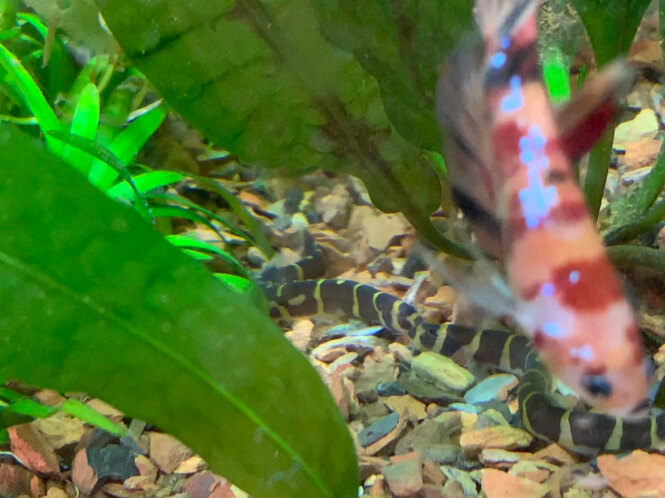
Here are two juvenile Kuhli loaches, being photobombed by a beautiful male betta in their 26-gallon bowfront community aquarium:
Busting the myths around perceived compatibility in community tanks
There are a couple of myths circulating the online space about bettas and their compatibility with the popular community fish.
Some are plain wrong and some have a skewed understanding of the real reasons behind them. Here are the myths around housing a betta with other community fish:
1. “Introduce your betta to the aquarium last.”
This myth implies that if you already have a solo betta you have a lower chance of successfully adding tank mates to its home.
Not at all correct.
Bettas are territorial and really do claim parts of the aquarium as their own. However, a simple rearrangement of the decor will force your betta to think that it’s a completely new habitat you’re putting it in.
Here’s how to get it to meet its new aquarium roommates:
- Remove the betta fish for a couple of days. House it alone in a different tank in the meanwhile.
- Rearrange the decorations of your existing main tank.
- Add the new tank mates 4 to 5 days prior to re-introducing the betta.
- Add the betta fish.
2. “Bettas will inevitably fight and kill new fish.”
If you don’t have a secondary bowl laying around then you can’t just drop the new residents in your existing betta tank, right?
Not really.
Betta fish get irritated by the unfamiliar movements and excitement of new fish.
This may result in a violent response, which is actually frustration undercover.
This gives both parties time to calmly explore each other along with their aquarium surroundings.
Mandatory surveillance
Keep an eye out for what’s happening in the tank after adding the new fish. There may be some initial aggression. If it’s only a matter of glaring and chasing there’s a good chance that it will pass in the next few days. However, if there’s constant fin-nipping, then perhaps your betta is not yet ready to live with others.
Also, mind the water temperature requirements of each fish you’d like to add to your betta tank. Most Danios and plecos, for example, are fish that prefer cold water aquariums. You can, however, strike a temperature balance in which all the aquarium mates would feel comfortable. If you’re housing danios along with a betta, the temperature should be diligently kept at 74.5 to 75° F. Make sure the aquarium’s equipped with a reliable heater that doesn’t take much space.
Prepare for the worst
In some rare cases it can’t be helped:
As I mentioned above some bettas won’t ever be able to live alongside other fish.
This is a species with a huge personality spectrum and that includes both ends.
If yours turns out to be a violent little villain then you should have a secondary tank to move him in.
Expect the best, but be prepared for the worst.
Bettas don’t get lonely.
They do, however, get bored.
If there are no sufficient hideouts and interesting plants to explore they may decide there’s nothing better to do than chilling on the bottom.
There are many other reasons for that (I linked you to an article where I describe them) but it most often happens because of lack of decor.
When living with others in nothing but an empty tank your little guy can become stressed from too much socializing and end up on the bottom again.
Always add lots of plants and hiding places to your betta tanks.
It’s best to buy a larger tank for more companion options
If you’re in the middle of your research and want to employ multiple fish you should consider getting a larger tank for your betta and its companions.
More living space equals fewer (possible) territory disputes among roommates.
If you’re in this phase of research I invite you to have a quick look at my guide on more beginner-friendly aquarium kits for new betta owners.
I made sure these tank kits have everything these fish would need. I’m also listing some more spacious options because I know they work better.
Visit the link and look at the 10 and 20-gallon tanks. These aquarium sizes are the best for housing multiple companion fish with a betta.
Final words
All of this is not rocket science and with the right approach, you can almost guarantee success. Many have done it before you, and now it’s your turn.
Choosing tank companions that will live in harmony with your betta fish takes nothing more than patience and being well-informed.
Leave me a comment below with your choice.






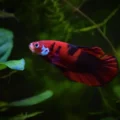





24 thoughts on “What Fish Tank Mates Will Get Along With a Betta?”